Star Trek and the Taming of the Borg
We look back on the rise, fall and eventual domestication of one of Star Trek’s most iconic aliens…
This article comes from Den of Geek UK.
When I was ten, I was a Borg. At least, I skewered a can opener through the end of an arm-sized cardboard tube, donned a black sweater and went lurching around a Star Trek convention until a trip to the dealers’ room united me with Peter David’s new novel, Vendetta – which, happily, also starred the Borg. (The arm came off at that point, because I couldn’t turn the pages properly using kitchenware.)
I wasn’t the only drone in attendance, though I’m pretty sure I had the cheapest costume, and books were just a fraction of the Borg-based memorabilia on display. Having recently made their first appearance on UK television, the Collective was everywhere.
Their success must have come as a huge relief to Paramount’s executives – after the capering Ferengi spectacularly failed to gain traction as the show’s signature baddies, they finally had a nemesis worth merchandising. And yet, despite the production team’s best intentions, the Borg would never be quite the same again.
The storm on the horizon
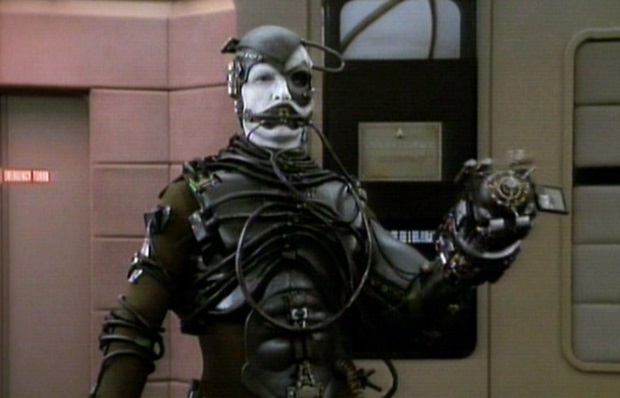
The Borg first made their presence felt in The Next Generation’s first season finale, having implicitly annihilated Federation and Romulan settlements dotted along the Neutral Zone. With a truncated second season and the pressure of a Writer’s Guild strike, however, plans for a measured introduction were scrapped in favor of a visit from Q – surely the handiest narrative shortcut since a malfunctioning holodeck – that dropped both the Enterprise and the audience into direct confrontation with the Collective.
Implacable and relentless, part of what makes the Borg’s first appearance so effectively chilling is the sheer disinterest they show towards sentient life in general. When one drone is taken out by phaser fire, another steps in to complete its task, newly-shielded but retaliating with nothing more than a reproachful stare. As responses go it’s unexpectedly alien and coldly logical: the Borg have no need to aggressively respond to an attack, because it’s making them stronger.
Picard and company are saved by Q after a quick grovel – an escape that must really have confounded the Collective – and Starfleet is given time to prepare for the Borg’s inevitable invasion. When the Borg do arrive in the Alpha Quadrant, it’s with a new agenda in mind; for the first time the concept of assimilation is raised, the term being coined by Locutus himself.
It’s an unsettling evolution of the purely consumptive Borg we’d been introduced to, and one the episode itself takes time to acknowledge. The idea that we might lose our identity and culture in the face of anonymising technology was very real at the time, and even now we’re still discovering what it means to have access to our own internet hive-minds. While some fans resented the change, the two-parter “Best Of Both Worlds” was a roaring success that left only one question lingering.
How on earth were the good guys going to win next time?
Only human
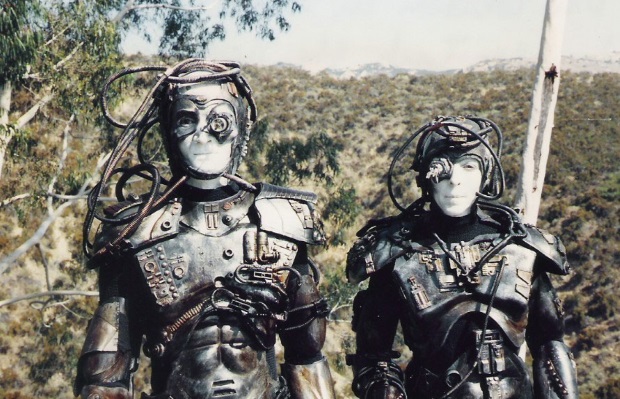
Starfleet has always made peace with its enemies. Whether it’s placing a Klingon on the bridge of the Enterprise or watching Nog become the first Ferengi ensign, it’s a long-running tradition for the show to take its former adversaries and have them accept Federation ideals. With the TNG writers well aware that repeated confrontations could only cheapen the Borg, perhaps it’s no surprise that their next appearance focused on a single, wayward drone gradually discovering the merits of identity.
“I, Borg” is a thoughtful, introspective piece with an ethical dilemma at its core – as well as some unusual interplay between Picard and Geordi, two characters who rarely interact beyond matters of technobabble. The central debate – whether the Federation is justified in wiping out a hostile species, let alone sacrificing an innocent life to do so – is certainly strengthened by their inclusion. It allows Picard, still wounded from his own abduction, to be at his most cynical while underscoring that the Borg, unlike the Federation’s other enemies, simply cannot be reasoned with.
Though it’s a fine episode, it’s far from a dramatic return for the Borg as a force to be reckoned with. Indeed, nobody aboard seems more than irritated by their most recent incursion into Federation space. Fans would have to wait for “Descent,” the season six cliff-hanger and a direct follow-up to the events of “I, Borg” to see the phaser fights and daunting Borg vessels they’d been waiting for.
Unfortunately, the Borg of “Descent” are almost unrecognizable; a cadre of aggressive brawlers who are embracing their newfound individuality and treat Lore, Data’s evil twin, as their mechanical Messiah. While it’s fun to see the Enterprise crew confronted by the consequences of their past actions, the two-parter feels like an unfocused muddle of ideas. Worse, it reduces the Borg to churlish clockwork Klingons with a generically evil agenda. Had Star Trek not endured beyond TNG’s final season, “Descent” might well have been the final nail in the Collective’s coffin.
Magic carpet ride
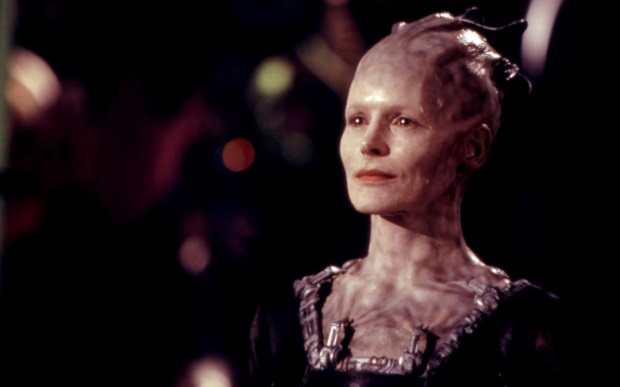
Star Trek, fortunately, was far from over. Both Deep Space Nine and Voyager kept the flame alive on TV while the Enterprise crew had graduated to the silver screen via the – often rather maudlin – Star Trek: Generations. Their next outing therefore promised to be an action-blockbuster of the kind only the cinema could provide, focusing on both time travel and the Borg.
While the events of “Descent” are quietly ignored by the film’s script, the story of Star Trek: First Contact necessitates some equally radical changes to the Borg as they attempt to subvert Earth’s historic first warp flight. Drones now more closely resemble the walking dead, swaying down corridors with mottled, greying skin and injecting their victims with nanoprobes to assimilate them – a futuristic zombie bite. These new Borg are able to convert the Enterprise just as easily, not so much assimilating as spreading like a technological fungus.
The redesigned drones make for excellent movie monsters, able to present a credible threat within the span of a single movie. For better or worse, their tactics in First Contact would go on to provide the template for all subsequent appearances, though it’s worth noting that some critics feel the tendency towards insidious, gradual corruption rather than brute strength and tenacity makes the Borg feel less unique, not to mention less scary.
Then there’s the Borg Queen who, depending on your point of view, can either be considered one of Star Trek’s greatest antagonists or a death knell for the original vision of the species. Her presence on the Enterprise provides a creepy, confident voice to explain the nature and drives of the Borg, taunt Picard and Data and serve as the Borg’s self-destruct switch when she’s defeated. Without her, these Borg truly would be zombies; automatons to be defeated with firepower rather than a battle of wills.
With her… the Borg are lessened. It’s a problem sci-fi shows often have to wrestle with. Once you can talk with your enemy, you can start to reason with them, negotiate with them, or just fool and distract them. The Collective is vulnerable to any mistake its Queen makes, because when she’s in play true autonomy is lost, and she’s just as susceptible to trickery and pride as any other movie villain.
Queen or no, there was no denying that the Borg did the business for First Contact. They were back in a big way, and their resurgent popularity meant they could once again appear in a show that was desperately seeking a good villain…
Collective uncertainty
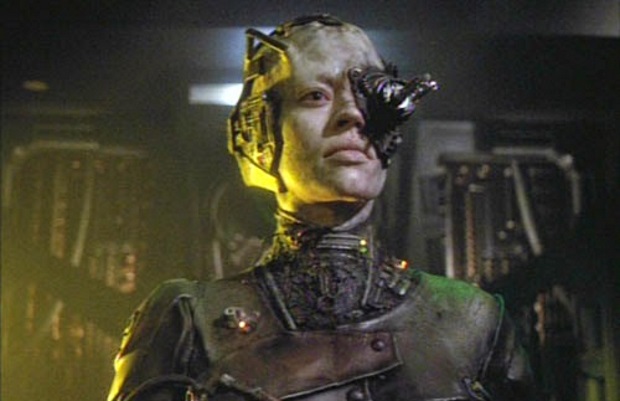
Introduced in the show’s fourth season, the shadow of the Borg looms large over Star Trek: Voyager. While they appear in force relatively sparingly, normally in season finales, their presence feels near-constant thanks to Seven of Nine, a former drone who spends the rest of the series rediscovering her humanity. That is, when she’s not talking about the Borg.
Seven of Nine talks about the Borg a lot.
Seven’s latent Borg knowledge makes her an expert on practically every species Voyager encounters. Seven’s Borg physiology makes her physically imposing and resistant to all sorts of space maladies. Seven’s Borg nanoprobes can do – well, absolutely anything the plot demands. At one point she’s even given a group of Borg kids to babysit, just in case the episode accidentally didn’t Borg it up enough to keep the audience engaged.
Though Seven herself is the star of some of the show’s strongest stories, this constant reliance on the B-word makes the Collective feel mundane, so that when the Borg do show up in an episode it’s oddly anticlimactic. The Queen, meanwhile, resorts to calling Voyager in person just to troll and threaten the crew, because she seems obsessed with getting Seven of Nine back into the Collective for reasons that are never fully explained.
As weekly villains, the Borg have to be at their most vulnerable. The show’s final episode sees a supercharged Voyager tearing into Borg space loaded with future technology, single-handedly taking out a pursuing cube. The Collective have been reduced to little more than cannon fodder, and they quite literally carry Voyager home.
Full circle
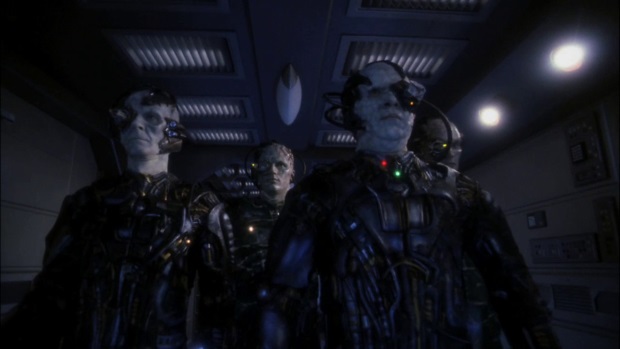
Perhaps inevitably, the Borg adapted, finding a way to live on through spin-off media after Voyager’s end. Thanks to spin-off novels and games they continued to threaten the Alpha Quadrant (not to mention eat Pluto) as well as invade the Las Vegas Hilton courtesy of Star Trek: The Experience.
Less than three years later, they were unexpectedly back on our screens. “Regeneration,” a second-season episode of Star Trek: Enterprise, raised a few eyebrows when it was announced, although the show had already introduced several anachronistic aliens – the Borg were, once again, set to follow the Ferengi as villains. While the drones involved are very much rooted in First Contact’s legacy – an entire wall transforms within seconds thanks to their ever-magical nanoprobes – it’s a tight, tense episode that focuses on how quickly a single Borg can get out of hand, and Archer’s realization that there’s no-one he can save.
The story ends with the drones informing their Collective of Earth’s location, implied to be the catalyst for their eventual incursions along the Romulan Neutral Zone. In that sense it functions as a bookend for the Borg, who’ve since spent fifteen years consigned to Star Trek’s Expanded Universe. But how long will they remain there, and how might they return?
In theory
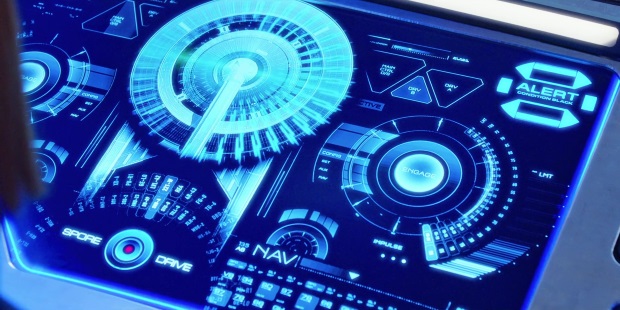
Sticking with the smaller screen for a moment, Star Trek: Discovery’s spore drive, while risky to use, is capable of sending the ship anywhere in our universe – not to mention parallel ones. While the show’s creators remain adamant they’re adhering to established canon, that doesn’t completely preclude Burnham and co. jumping into Borg territory by mistake, just as long as Section 31 hushes everything up afterwards.
Perhaps we should be looking back to the feature film for more fertile ground, though. The ‘Kelvin Timeline’ Star Trek movies have already wildly diverged, and their advanced technology could be reason enough for the Borg to come sniffing around earlier than expected. As it’s looking likely we’ll see just one or two more instalments, it’s not hard to imagine that someone at Paramount is doodling cubes on a post-it note right now.
However the Borg return, there’s no shortage of ways to reinvent them, given that we live in an age of constant connectivity, 3D printing and are even starting to utilise prosthetics controlled directly by our brains. If the Borg are to be truly terrifying, they must once again present something alien, something that thinks and behaves in a way we can barely comprehend. And yet, something that very clearly used to be like us.
